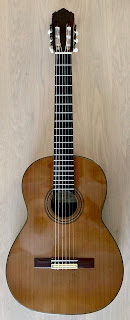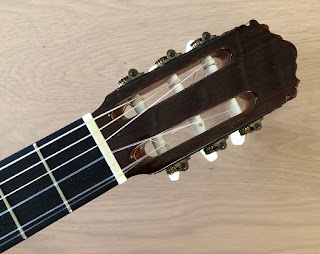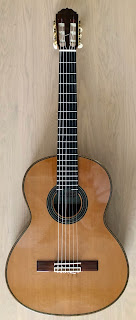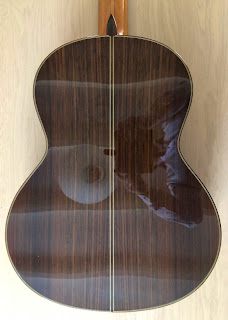Presented here is the top model of Amalia Burguet,
the so called AB (Amalio Burguet) model. I'm not sure
wether if every AB model has been equipped with a
so called "Doble Tapa" which means a layer of a softer
wood (spruce) sticked to the back, the way Manuel
Contreras reintroduced. This one is provided with
this double top (or back). Besides that the sides have
been veneered with a layer of Cypress from the
inside. Difficult to detect differences between these
models and a 'normal" guitar but the response of the
higher notes is beautiful rounded and very even in
sound and in fact comparable to a Jose Ramirez 1A
which is no surprise as Buguet also built guitars in
the "Madrid". tradition. Lot's of volume, a bit darker
sounding and a good playability at the same time.
Scale is 650 mm. List price at this moment: Around
5900 Euro's. For this example case included:
Price € 2500,-
The head presented here has the carving "AB" in
the furthermore graceful head design.
A fine grained spruce top with a bracing of its' own.
You can't describe it as a lattice bracing but it is also
far from a traditional fan bracing. More about this
bracing and a slight problem around it further here
The rosette as well as the edges are beautiful executed
regarding inlay work.
I've included this picture as you can see a varnish
crack that runs from the bridge to the sound hole
on the left. As a restorer you would like to know
wether it is a crack all through the wood or just
in the top layer of the varnish. Therefore a light
bulb works well, especially with a spruce top as
this wood shines through. Together with a close
inspection with a mirror the conclusion can be
drawn: No crack on the inside visible but the
cause became clear to me:
One of the braces for the soundboard in that area
came loose in the past, thus causing a weak spot in
the soundboard there as a result from the tension
of the strings. Regluing the brace was not a big
problem and strengthening the spot in this way
has been executed. It doesn't' has any influence
on the final sound.
For me a bit of an odd looking type of rosewood though
investigations learned that Burguet uses Madagascar
rosewood for his premium model guitars.
Great tuners as well and I think we have to be grateful
the older Spanish luthier companies stopped using the
Fustero tuners as the company no longer exists. They
made beautiful tuners but mechanically spoken not the
top. These tuners are the top line of Gotoh 35AR510P.
but also can be found on the internet under "Gotoh
Hauser" tuning keys. (See below)
For more information please click on the picture. These
tuners are far superior to any others I've come across,
including the Fustero's and other brands.
And with their knobs clinched on the axes.
As can be studied here: No fret wear. In fact a guitar like new!
It comes together with a like new case.
Amalio Burguet Model 1A 1988
Presented another and probably the most popular
model in their range, the 1A model. Here beyond
I will discuss the Maestro model which is discon-
tinued but would cost about a 1000 euros more.
These 1A models are really good value for money.
Scale length: 655 mm. Width topnut: 53 mm.
Price in very good condition here: SOLD
They are equipped with either a spruce or a cedar top.
This one has a cedar soundboard. This guitar furthermore
is provided with an ebony fingerboard. The string tie
block is surrounded by a hard material which will prevent
any damages caused by the tension of the strings.
This guitar made his years so chances are little
that unwanted cracks will occur due to an improper
construction detail somewhere. Made in 1988.
Both the neck and the back are free from nicks, dings
and scratches. A good and straight neck with enough
neck relief to let the strings vibrate freely.
You can enlarge the picture but as always there
might be some strange spots due to reflections
while photographing so no damage here on the
right side of the guitar near the waist.
Sometimes inevitable damages might occur when placing
a guitar against a wall. Nothing to be seen here. The wider
ebony inlays in the back of the neck appear to be less wide
on more recent models. And let's not forget that the sources
to obtain the right woods are diminishing nowadays.
No cost saving moves on the choice of the tuners though
as always with older Spanish or classical guitars, the plastic
rollers often are cracked after a period of time, often
due to the expansion of the metal parts inside when
temperature changes are involved. These cracked ones
have been replaced with newer ones.
A remark could be made here as more than often these
small damages can be seen behind the string tie block of
a bridge when the higher strings pop off. Some string
companies provide their higher strings with a small ball
to prevent the string from slipping. In other cases it is
advisable to make a knot at the end of the higher strings
to prevent these damages. Simply filling them with
varnish and / or super glue will cause a dark trace
especially on cedar topped guitars. It is better to colour
them first with paint to match the rest of the soundboard
and then use super glue that will mix very well with
the lacquer surrounding the area.
The fret wear can be studied here and for that reason
the second string has been pulled out of the topnut.
Amalio Burguet Model "Maestro" guitar 2007
Presented here is a beautiful Amalio Burguet guitar.
Some work on this one but nothing serious. I will explain
the damages later here. Model "Maestro" which isn't
in the collection offered today. It was two models above
the model 1A and with a retail price what would be
3500 euro's nowadays, the price was much more
agreable recently. SOLD.
In fact very little damages apart from the sometimes inevitable
dings behind the bridge caused by strings that sometimes
jump loose and that counts for the highest strings. This problem
can be avoided by making a knot at the end of the string.
This guitar has been built in the month September in the
year 2007. Signed by the luthier himself. It is just under
their premium concert guitar (but sometimes might even
sound better.) Comparing prices with their 2021 pricelist
the amount for the more expensive guitars went up to
about 33 %!
A nicely shaped head with good tuners and
a newly made topnut as I'm always opting
for a bit more room from the first string to
the edge of the neck. Width topnut: 53 mm.
The rosette and the narrow grained cedar top can be
studied here and a closer look at the rosette as well.
This is what happens when the strings jump loose.
Always the two or three highest strings because
they are more slippery. The result is almost always
a kind of scratch behind the bridge. Not deep but
deep enough to expose the bare wood. Moisture
now has a chance to get into the soundboard but
filling the small gap with lacquer always results
in a very dark (ugly spot) I always try to match the
color of the soundboard with oil paint and I fill the
small gap with super glue that really hardens out well
and mixes with the lacquer surrounding these spots.
Therefore the spot will be more resistant in the
near future for this unlucky accidents. Depending
on how the light reflects it is more or less visible.
Another worry for guitarists are the condition of the frets
on the guitar. I will always make a picture of the frets,
especially at the beginning of the fingerboard and under
the second string as that place most of the time has been
played a lot. With wear as a result. No wear here.
The back is in a pristine condition as is the back of the neck.
Beautifully inlayed and where these guitars shine is their sound
of course. Really Spanish and most of the time at a reasonable
price. Also the 1A models can be very surprising! However
the new models have another scale length and cannot be
compared with these older ones. To my opinion, the older
guitars got more attention in building specs and regarding
the choice of woods.
A closer look is even possible here.
And no damages on the head caused by placing the guitar
against a wall. No cracks or other vital imperfections.
Visible here is the reinforcement of the neck that in fact
is identical to the more recent 1A models.

































.jpeg)





















